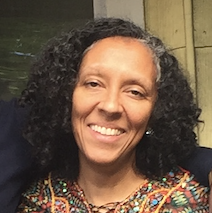Tag Archive: learning
March 10, 2018
“Relationship is the fundamental truth of this world of appearance.”
-Rabindranath Tagore
The following is a segment from the first post in a series focused on network theory and its actual and potential applications to education and learning. This series appears on the Education Week website and was invited by Next Generation Learning Challenges (NGLC) as it explores the potential of networks to advance equity, adaptability and excellence in public education …
Network theory is on the one hand a new and emerging interdisciplinary science and on the other hand it is ancient, grounded in indigenous and experiential ways of knowing about the reality of interconnectedness. Another important element of “network science” is imagination–the use of creative expression and metaphor that recognizes and works with relationship and relatedness that can help to guide our minds, hearts, and hands. These posts will draw insight from this broader understanding of network theory. This first post offers a larger view of the nature and potential of networks in our lives.
There is a lot of talk about networks these days. And there is considerable hope and effort being put into more interconnected ways of working and learning in order to bring about much needed innovation and change in multiple fields, including education. This is exciting, and at the same time I am concerned that the conversation can be relatively narrow, or leap ahead of some deeper insights of network theory and practice. In so doing there is a risk of not getting to the more promising potential of networks.
Connection is fundamental. This is a core observation of network theory (and various wisdom traditions). Network theory starts by pointing to the fact that we often talk about the world in terms of individual things and their properties. This kind of approach may work in situations and in systems that are fairly simple and relatively static. But when the interactions and the complexity of the elements in a system increase, it is the connections that determine the characteristics of the elements in the system and its overall health. This holds true for any kind of dynamic living system–ecosystems, human communities, economies, etc.
“Network theory suggests that what a system becomes emerges from the complex, responsive relationships of its members, continuously developing in communication.”
-Esko Kilpi
Life is at base a network. It thrives on connection. We all know this, experientially, because we are alive! And when we are not feeling alive or lively it is often because we are disconnected, cut off in some way–from other people, from the natural world, from our selves (feelings, bodies, values), from power or a sense of purpose. (See the UK’s recent move, incidentally, to appoint a Minister of Loneliness to address the multiple ills stemming from growing social isolation). Life thrives on connection. …
To continue reading this post, follow this link.
February 19, 2018
“It’s not knowing what to do that counts, it’s knowing what to do when you don’t know what to do.”

Last week I had the privilege of co-leading a three day Facilitative Leadership for Social Change training for a group of health equity advocates in Springfield, Massachusetts. It had been a while since I had done a training of that length, and it was a nice opportunity to not only cover more material, but to deepen the conversation and practice. Along the way there were many good questions about what to do around various challenges when one is co-leading a collaborative change effort. And a common response was, “It depends.”
Every group is different, every circumstance is different, and while it might make sense to take some cues from what has been successful in other situations, the caution is not to assume that it will work, or work in the same way, in other situations. This is one reason that I personally do not like the phrase “best practice” when talking about collaborative and facilitative change work. Given the complexity of people and social systems, I find it more helpful to think about “promising practices.”
That said, a promising practice that came up time and time again in our three day training, was the practice or practicing, of ongoing devotion to muscle-building in leadership skills such as process design, facilitation, coaching (leading with listening and inquiry), systems thinking, visioning/imagining, mutual learning and collaborative decision-making/governance. And in undertaking such practice, we at IISC would suggest this is not about achieving perfection. The humbling and exciting thing about collaborative leadership, in my humble opinion, is that it is a life-long learning pursuit and an endless opportunity to deepen understanding of ourselves, others and living systems. For this reason, one of my mantras is:
Practice for presence, not for perfection.
That is, practice can help practitioners get beyond being caught up in simply “learning the scales” of collaborative leadership, in trying to get the skills “right.” Practice at its best can contribute to a state of being more fully present to what is happening in any given situation and being able to work with that in powerfully improvisational ways.
Furthermore, over the past year, there has been a clear call for practice and practices that are explicitly about cultivating spaces to hold difference and tension and trauma. That may be another order of presence characterized by a deeper tuning in and movement away from more transactional processes to ones that are emergent, co-created and geared towards supporting moral courage and imagination. What that can require is vulnerability and a humble sense of “being with.” What it stands to make possible, as opposed to business-as-usual, is growth and real movement forward, together.
August 1, 2016

I recently re-read portions of Limits to Growth: The 30 Year Update by Donella Meadows, Jorgen Randers and Dennis Meadows. This second update to the original 1972 report from the Club of Rome affirms that current business-as-usual resource usage globally has our socioeconomic systems headed toward collapse shortly after the year 2050. The update reiterates the necessity of taking the impending crisis seriously and mobilizing quickly to adopt strategies such as:
While all of this serves as a strong wake-up (or stay awake) call, what most caught my attention was the concluding chapter, where the authors move from discussion of the technical fixes required to get us on the right track to a serious appeal to more adaptive approaches. Read More
May 31, 2016

Last week I attended another meeting of the Research Alliance for Regenerative Economics (RARE) and we deepened our conversation about a “regenerative framework” for guiding system change. Underlying our conversations is the premise that many living systems – ecological, economic, social – are reaching or have already reached a point of crisis where they can no longer respond to changing conditions in such a way that humanity, or significant portions thereof, can thrive. Another way of saying this is that these systems are losing their capability for resilience (to “bounce back” from perturbations) and regeneration (to self-organize and evolve). Our discussions are focused specifically on the dynamics of networks, human and otherwise, and what these can tell us about why we are where we are socially and ecologically and what can be done to alter current conditions and humanity’s long-term prospects.
Breeding disconnection, diminishing diversity and stemming resources flows is “irresponsible.”
Read More
May 10, 2016

This year for the second time, IISC partnered with Food Solutions New England in designing and facilitating the 21 Day Racial Equity Habit Building Challenge as an extension of both organizations’ commitment to realizing racial justice.
Last year, this networked remix of an exercise created by Dr. Eddie Moore, Jr. and Debby Irving, was offered as a way of spreading commitment to learning about, talking about and taking action to solve racial injustices in the food and other related systems. This year, additional tools and virtual platforms were added to create a more robust environment for learning. This included:
- an even richer resource page with readings, videos and organizational links,
- a blogroll of daily prompts with links to resources and room for participants to offer written reflections,
- a series of original blog posts on the FSNE website committed to relevant topics and themes
- a Twitter hashtag (check out #FSNEEquityChallenge)
- a group Facebook page
Read More
October 27, 2015
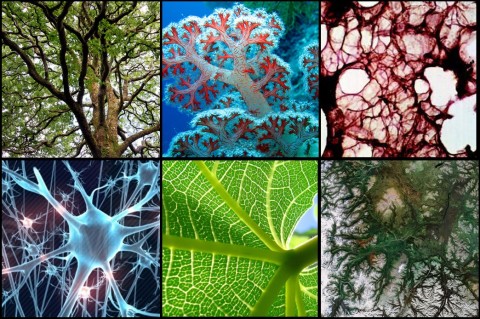
I’m working with a social change network that is evolving its structure to make better use of existing resources, and we have talked about how aligning more explicitly with network principles, both in its structural design and operations, might help with this. Culling through a variety of principles from other networks with which I’ve worked, I’ve come up with the following dozen examples:
Read More
July 22, 2015
“We are actually waiting for civilization both to learn and reorganize itself with more intricacy, more collaborative coherence and greater social intelligence.”
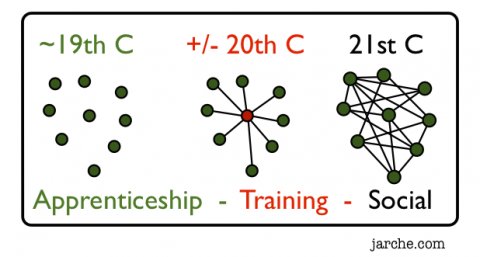 Two weeks ago I wrapped up Harold Jarche’s on-line course on social learning and am committing to practicing some of what I learned through blogging as “learning out loud.” This is not an entirely unusual practice for me, but Harold has helped me to better appreciate the value of turning off the critic and putting “rough draft thinking” out there, as a way of crystalizing and mastering my own knowledge but also (possibly) connecting it to others who may be on the same wavelength/ have similar lines of inquiry and (perhaps) contributing to social change. Preposterous? Maybe.
Two weeks ago I wrapped up Harold Jarche’s on-line course on social learning and am committing to practicing some of what I learned through blogging as “learning out loud.” This is not an entirely unusual practice for me, but Harold has helped me to better appreciate the value of turning off the critic and putting “rough draft thinking” out there, as a way of crystalizing and mastering my own knowledge but also (possibly) connecting it to others who may be on the same wavelength/ have similar lines of inquiry and (perhaps) contributing to social change. Preposterous? Maybe.
But consider how our understanding of how the world works is shifting through our ability to see connections, appreciate the social creation of knowledge and grasp the emergent nature of change. Seeing reality through a living systems lens helps us to understand ideas as seeds, expression as sowing, interaction as fertilizer and social networks as the metabolic infrastructure to bring new things fully to fruition. Read More
July 15, 2015
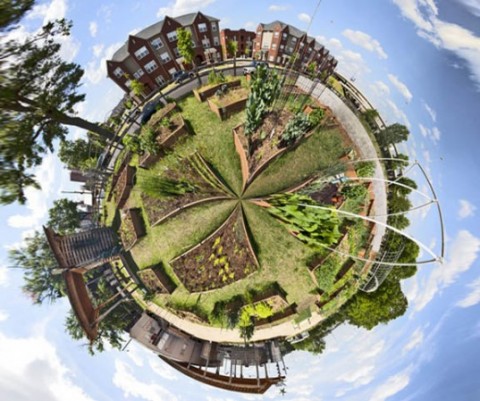
I posted the following about five years ago on this site, and have been actively thinking about and experimenting with its core lessons ever since. I have only become more compelled by the need to bring a living systems orientation to work for social change. Curious to hear reactions and what you are already doing to apply insights from and living systems.
Part 1
Last week I was in the presence of a master. For more than 25 years, Lauren Chase-Rowell has skillfully and intuitively cultivated the land around her house in Nottingham, NH to the point that it exists in great harmony with the beautiful farm house, people and fauna occupying that space. Lauren is an ecological landscaper, organic farmer, and permaculture design teacher. Her home, Dalton’s Pasture Farm, is a vibrant classroom and testament to the possibility of practicing “earth-centered living.” Read More
June 25, 2015
“A beautiful question is an ambitious yet actionable question that can begin to shift the way we perceive or think about something – and that might serve as a catalyst to bring about change.”
– Warren Berger
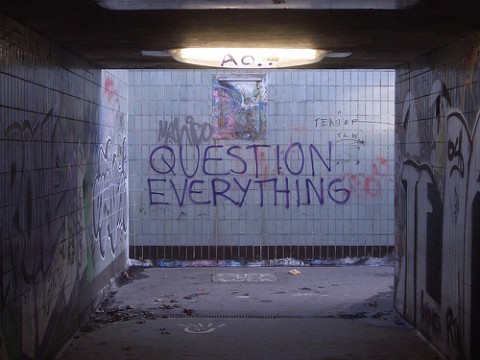
Photo by Duncan Hull
One of my favorite reads of the past couple of years is Warren Berger’s A More Beautiful Question: The Power of Inquiry to Spark Breakthrough Ideas. It continues to strike me as being an important book for any social change agent. Early on, Berger begins with the following provocative statement, that rings true to personal experience:
“Well meaning people are often trying to solve a problem by answering the wrong question.”
In some cases this is because they have not paused long enough, if at all, to consider the underlying question their efforts are trying to solve (risking “active laziness” which I blogged about a couple of weeks ago). Or, as my colleague Cynthia Silva Parker has said, they are “solving for solution,” essentially promoting and/or fighting over their own preferred approaches. And so they continue to offer the same old, ineffective and outdated, approaches or products. This is especially problematic in a time of such change and flux, when we can’t fall back reliably on what we already know. Read More
November 21, 2014

It probably goes without saying that learning requires reflection. This holds true for individuals and groups, and yet what I find is that many collaborative efforts can fail to build adequate reflection time into their work. Often it seems that reflection can be cast aside in favor of “getting stuff done” and because, “There is so much to do!” And ironically, what can ensue is an overall and ongoing sense of impatience and frustration that “we aren’t doing anything or enough.” Experience shows that when people in networks and collaborative change work do pause to reflect, there is much value to be gained.
The other day I worked with the core team of a regional network focused on food system change, and we took time to reflect on what the past couple of years of work have yielded at individual, collective and systemic levels. People offered up their own reflections, as well as those garnered from informal interviews with others in the network. The result was eye-opening, affirming and provided a collective boost. What we agreed is that considerable and important development has occurred over time, including: Read More
August 11, 2014

Photo by Synopia
A number of readings I’ve come across lately reference the important consideration of organizational structure and how it encourages or discourages collaboration. In a post from last week, I highlighted the book Reinventing Organizations by Frederic Laloux, which focuses on “evolutionary (Teal) organizations” that embrace an ethic of self-organization to facilitate more purpose-driven, holistic and responsible engagement on the part of organizational members. In order to encourage self-organization and intrinsic motivation, these entities adopt less formally hierarchical and fixed-role structures in favor of fluidity and networked leadership. According to Laloux, this brings more timeliness and relevance to the inner workings and responsiveness of these organizations. Read More
July 18, 2014

We partnered with a foundation as they built a network of leaders who shared a deep passion for their city. In the beginning, many of the leaders wanted to do something together quickly. We encouraged them to pause, build deeper relationships, and see what emerged. Read More












